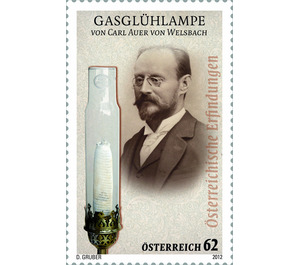inventor - Austria / II. Republic of Austria 2012 - 62 Euro Cent
Theme: Science
| Country | Austria / II. Republic of Austria |
| Issue Date | 2012 |
| Face Value | 62.00 |
| Edition Issued | 812,000 |
| Printing Type | offset |
| Stamp Type | Commemorative |
| Item Type | Stamp |
| Chronological Issue Number | 2367 |
| Chronological Chapter | OOS-OE2 |
| SID | 797119 |
| In 58 Wishlists | |
With Carl Freiherr Auer von Welsbach starts the new attractive brand series "Austrian inventions", in the course of which well-known pioneers of domestic research history are presented. The chemist and entrepreneur Carl Auer von Welsbach (1858-1929) not only acquired great merit as the discoverer of the four chemical elements neodymium, praseodymium, ytterbium and lutetium, but above all as inventor of the mantle in gaslight, the so-called "gas light bulb". as shown on the mark. In addition, the metal filament lamp and the flint in the lighter on Auer of Welsbach's ingenious research spirit go back. Already during his studies at the Universities of Vienna and Heidelberg, he began in the laboratory of Prof. Adolf Lieben with studies on the metals of the rare earths. After completing his doctorate in May 1882, Auer von Welsbach devoted himself to various experiments, among other things he observed the glow of the compounds of the rare earths in the flame of the Bunsen burner. When he soaked cotton threads with their salt solutions and burned the dried threads, a skeleton of oxides remained, which showed strong radiance. For example, Auer von Welsbach invented mantle stocking in 1885, also known as "Auerstrumpf", which significantly improved the already well-known gas lighting, since it achieved significantly better light yields with lower gas consumption. After he had optimized the composition, the gasglass was far superior to all other light sources known at that time. It was not only much brighter than a candle or Kienspan, but also cheaper than other gas lamps or for example the electric carbon filament lamp. In this way the invention also became a commercial success. Nevertheless, Auer von Welsbach also dealt with the electric light - and in 1898 he patented the first usable metal filament lamp. He developed a process for making wires of osmium, which was then considered to be the metal with the highest melting point. On March 10, 1906, Carl Freiherr Auer von Welsbach, who was regarded as the epitome of a diligent, taciturn researcher and scholar, announced the still existing trademark "Osram" for "electric incandescent and arc light lamps" at the then Imperial Patent Office in Berlin. The renowned Auer von Welsbach Fellowship, a lecture hall named after him at the Institute of Chemistry at the University of Vienna, the popular Auer-Welsbach-Park in the 15th district of Vienna, and the streets in Vienna-Liesing and Berlin-Friedrichshain which he honored, certainly still today to the great Austrian inventor.


